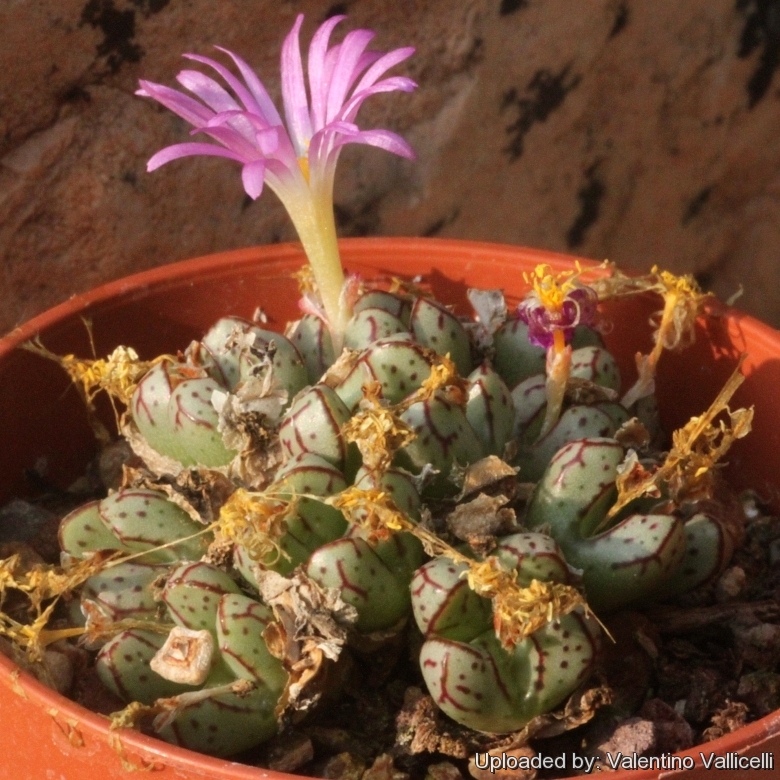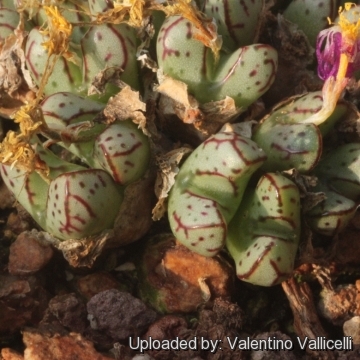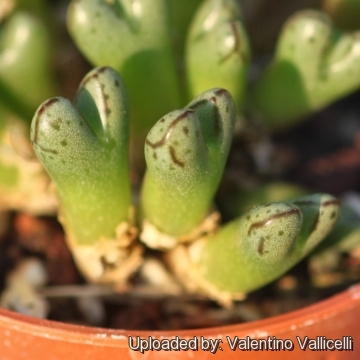Accepted Scientific Name: Conophytum tantillum subs. helenae (Rawé) S.A.Hammer
Cact. Succ. J. (Los Angeles) 63(3): 140. 1991

Conophytum helenae (Conophytum tantillum subs. helenae) Photo by: Valentino Vallicelli
Conophytum helenae RR1635 (MG 1425.7) Kosies, tiny bodies, purple flowers.
Origin and Habitat: Namaqualand, Northern Cape, South Africa.
Habitat: It grows on on granite or quartz cliffs or pans.
Synonyms:
See all synonyms of Conophytum tantillum
Description: Conophytum tantillumSN|18625]]SN|18625]] subs. helenae is a small densely branched species forming tight or loose flat mats. Plants of this subspecies “retracts” as summer approaches, and then the sheaths are tightly sealed over the body.
Stem: It is almost stemless.
Bodies (paired leaves): up to 10 mm tall, 18 mm in wide, cylindric below, apex faceted, bilobed, keels asymmetrical sharp often multiple, pale green, yellowish-green or reddish, glabrous, with green striations, and have prominent dark red margins, sheaths brown very firm.
Flowers: Petals pink, magenta. They are simple, daisy-like, early diurnal.
Blooming season: They arise at the beginning of the growing period in September to October. Seedlings are capable of bearing flowers within 2 to 3 years.
Fruit: 4-5 locular.
Subspecies, varieties, forms and cultivars of plants belonging to the Conophytum tantillum
 Conophytum tantillum N.E.Br.: Petals white to pinkish. Leaves greyish-green, plant polyploid. Distribution: Northern Cape, South Africa. Geelvlei Plateau around Steinkopf and Springbok
Conophytum tantillum N.E.Br.: Petals white to pinkish. Leaves greyish-green, plant polyploid. Distribution: Northern Cape, South Africa. Geelvlei Plateau around Steinkopf and Springbok Conophytum tantillum subs. amicorum S.A.Hammer & Barnhill: Bodies thick, always unlined, subtly keeled.Flowers yellow. Distribution: South west of Steinkopf, Northern Cape, South Africa
Conophytum tantillum subs. amicorum S.A.Hammer & Barnhill: Bodies thick, always unlined, subtly keeled.Flowers yellow. Distribution: South west of Steinkopf, Northern Cape, South Africa Conophytum tantillum subs. eenkokerense (L. Bolus) S.A.Hammer: has body-markings consisting of linked green spots.
Conophytum tantillum subs. eenkokerense (L. Bolus) S.A.Hammer: has body-markings consisting of linked green spots. Conophytum tantillum subs. helenae (Rawé) S.A.Hammer: Petals magenta. Distribution: Namaqualand, Northern Cape, South Africa.
Conophytum tantillum subs. helenae (Rawé) S.A.Hammer: Petals magenta. Distribution: Namaqualand, Northern Cape, South Africa.- Conophytum tantillum subs. inexpectatum S.A.Hammer: Bodies slender, usually lined with red or green, glabrous.
- Conophytum tantillum subs. lindenianum (Lavis & S.A.Hammer) S.A.Hammer: Leaves yellowish-green, plant diploid.
Notes: Plants of the genus Conophytum are also known as 'living pebbles'. During the rest period (the summer months in Europe) a new body forms inside the old, gradually taking all the substances from it until all that remains is the skin, which dries and protects the young plant from the heat of the sun and excess evaporation of water. The resting Conophytum protected by this dry cover resembles a pebble and hence the name 'living pebble'. The growth period of most species is from August to March. The temperature should be about 10 to 12°C.
Bibliography: Major references and further lectures
1) Cholo, F. & Raimondo, D. 2008. Conophytum tantillum N.E.Br. subsp. helenae S.A.Hammer & Barnhill. National Assessment: "Red List of South African Plants" version 2013.1. Accessed on 2014/01/30
2) Nicholas Edward Brown, A. Tischer, M. C. Karsten “Mesembryanthema; Descriptions: With Chapters on Cultivation and General Ecology” L. Reeve, 1931
3) Gordon D. Rowley “The illustrated encyclopedia of succulents” Crown Publishers, 01/Aug/1978
4) James Cullen, Sabina G. Knees, H. Suzanne Cubey “The European Garden Flora Flowering Plants: A Manual for the Identification of Plants Cultivated in Europe, Both Out-of-Doors” Cambridge University Press, 11/Aug./2011
5) Hammer, S. 1993. “The Genus Conophytum - A Conograph.” Succulent Plant Publications, Pretoria.
6) Hammer, S. 2002. “Dumpling and His Wife: New Views of the Genus Conophytum.” East Anglia Engraving Creative Colour Ltd, Norwich, England.
7) Ernst Van Jaarsveld, Ben-Erik Van Wyk, Gideon Smith “Succulents of South Africa: A Guide to the Regional Diversity” Tafelberg Publishers, Limited, 01/lug/2000
8) Heidrun E.K. Hartmann “Illustrated Handbook of Succulent Plants: Aizoaceae A-E” Springer, 2002
9) Werner Rauh “The Wonderful World of Succulents: Cultivation and Description of Selected Succulent Plants Other Than Cacti” Smithsonian Institution Press, 1984
10) Hermann Jacobsen “Lexicon of Succulent Plants” Littlehampton Book Services Ltd. 1974
 Conophytum helenae (Conophytum tantillum subs. helenae) Photo by: Valentino Vallicelli
Conophytum helenae (Conophytum tantillum subs. helenae) Photo by: Valentino Vallicelli Conophytum helenae RR1635 Kosies, this form has very small bodies. (Conophytum tantillum subs. helenae) Photo by: Valentino Vallicelli
Conophytum helenae RR1635 Kosies, this form has very small bodies. (Conophytum tantillum subs. helenae) Photo by: Valentino VallicelliCultivation and Propagation: It is relatively easy to grow. These plants grow on winter rain and head for summer dormancy. More or less dormant in summer.
Soil: Use well-drained soil mix.
Water: The plant requires little water; otherwise its epidermis breaks (resulting in unsightly scars). Water throughout the year although minimally in summer, (only when the plant starts shrivelling), but it will generally grow even in summer if given water. Water regularly in winter after the previous year's leaves have dried up. Requires good drainage.
Exposure: Plants prefer morning sun and some protection against afternoon hot sun in mid-summer; it needs full sun or light shade in the other seasons. Keep dormant in summer and keep protected during this period.
Hardiness: Hardy to -2°C. Ensure a very good ventilation.
Maintenance: Avoid to repot frequently. This plant may stay in the same pot for many years. Plants grown in larger containers have frequently relatively poor flowers. It might improve when the plants are given their own, small individual pots. With age the plants can grow raggedly leggy and it is best to renew them from cuttings.
Propagation: It can be reproduced both by cuttings and seeds. Take the cutting from a grown-up mother plant. Each cutting must contain one or more heads, along with a fraction of root.












